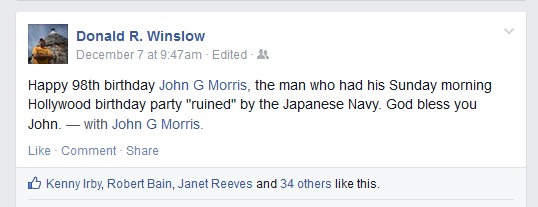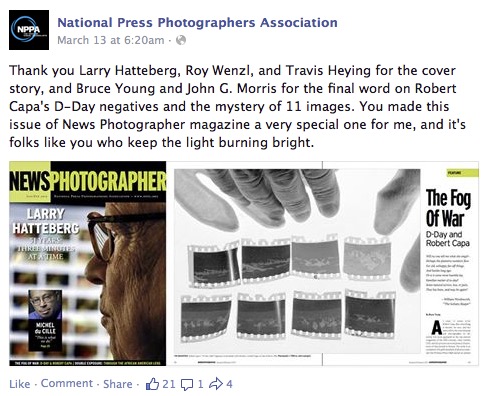 Over the past week I have re-read several times “The Fog of War: D-Day and Robert Capa,” the feature article by Bruce Young about the investigation of the Capa D-Day myth ongoing here at this blog, published in the current issue (January-February 2015) of News Photographer, house organ of the National Press Photographers Association (NPPA). I’ve also reviewed my own measured responses thereto.
Over the past week I have re-read several times “The Fog of War: D-Day and Robert Capa,” the feature article by Bruce Young about the investigation of the Capa D-Day myth ongoing here at this blog, published in the current issue (January-February 2015) of News Photographer, house organ of the National Press Photographers Association (NPPA). I’ve also reviewed my own measured responses thereto.
Upon further reflection, with a bit of distance from the material, I discovered to my chagrin that I’d scanted one of the core issues — the self-evident conflict of interest inherent in the NPPA’s publication of this article. I’d raised the issue of full disclosure without specifying that the field of journalism (of which photojournalism is a subset) considers this not just optional but actually mandatory in a situation such as this. The conflict of interest in this instance is so grave that it should actually have precluded publication of the article.
In short, the appearance of this article in News Photographer without indication of the NPPA’s deep historic ties to John Morris, editor Donald Winslow’s personal and professional connection to Morris, and Winslow’s and Young’s unabashed reverence for Capa, manifested a fundamental unethicality. Like much else, it reinforces the impression that while the NPPA’s hierarchy and membership claim to operate by and even exemplify the highest standards of professional journalism, they feel entitled to play by a different set of rules.
To put that perception to the test — given that they pride themselves on their commitment to the ethics of photojournalism — I filed the following formal complaint with Sean D. Elliott, Chair of the NPPA’s Ethics Committee. I did so via snail-mail on April 6 (the USPS confirmed delivery just before 8 a.m. on that date) and email on April 7.
•
Sean D. Elliott, Ethics Committee Chairman National Press Photographers Association c/o The Day Publishing Company 47 Eugene O’Neill Drive New London, CT 06320-1231RE: Call for an ethics investigation of Bruce Young; Donald Winslow; the National Press Photographers Association’s journal, News Photographer; and the NPPA
Dear Mr. Elliott:
I herewith file a formal complaint of breach of journalistic ethics against Bruce Young; Donald Winslow; the National Press Photographers Association’s journal, News Photographer; and the NPPA itself.
The basis of the complaint is “The Fog of War: D-Day and Robert Capa,” the feature story published in the current issue of News Photographer (January-February 2015, pp. 48-56), commissioned by Winslow, editor of this publication, from writer Bruce Young.
The cause of the complaint is the failure of Young, Winslow, and the NPPA to perform the mandatory full disclosure of the vested interests of all these parties, and the organization itself, in protecting the reputations of photojournalist Robert Capa and picture editor John Morris, along with such institutions as TIME, Inc., Magnum Photos, and the International Center of Photography.
All of those just mentioned stand implicated in a long-term cover-up of the truth about Robert Capa’s actions on Omaha Beach on D-Day, June 6, 1944, and the subsequent fate of his negatives. The ten-month investigation of this conspiracy, led by myself in collaboration with photojournalist J. Ross Baughman, photographer Rob McElroy, and others, serves as the central subject of Young’s article.
Though notable by its absence from the NPPA’s Code of Ethics, the obligation of what professionals in the field call “full disclosure” is considered incumbent on writers and editors by virtually all other organizations of journalists and news-gathering enterprises. As I gather this concept is new to you, attached you’ll find a primer including extracts from the guidelines of such sources as the Pulitzer Center; the Society of Professional Journalists; National Public Radio (NPR); the New York Times; the Denver Post; the Graduate School of Journalism, City University of New York; and the National Scholastic Press Association (NSPA).
The following breaches of the requirement of full disclosure occur within the article itself, and in its publication in the NPPA’s journal of record bearing the NPPA’s imprimatur. Specifically:
• The article’s author, Bruce Young, had previously identified himself as a “Capa-phile” in an earlier piece published at the NPPA’s website, “Death In The Making … For The Last Damned Time” (July 28, 2009), this one on the controversy over the authenticity of Capa’s Spanish Civil War image “The Falling Soldier, 1936.” In his fall 2014 emails to Baughman asking questions about our investigation Young further declared himself a “Capa defender” who is “inclined to give Capa a break.” Given that prejudice, he had an obligation to either recuse himself from this assignment or make his patent bias clear to News Photographer‘s readers, but failed to do so. Certainly that made him an unlikely candidate to produce “a neutral piece accounting for everyone’s stories and claims,” as Young described his assignment from Winslow in a January 2015 email soliciting my responses to a series of questions about the project. And, indeed, it’s demonstrably not what appeared in the magazine.
• Young’s bias was certainly known in advance to Donald Winslow, who edits both News Photographer and the NPPA’s website, and who has served as the NPPA’s publications editor since 2003. Thus Winslow commissioned and published the 2009 piece in which Young declared himself a “Capa-phile.” Yet, knowing this, Winslow commissioned from Young a new piece on an investigation challenging aspects of the Capa myth, without disclosing in an editor’s note Young’s known bias, or requiring Young to do so himself.
• Presumably that’s because Winslow shared that bias toward Capa, and a bias in favor of picture editor John Morris, another subject of our investigation. Winslow has commissioned texts from Morris for both the magazine and the website. Winslow considers Morris a friend and colleague; on Morris’s birthday, December 7, 2014, Winslow posted a note on his Facebook page calling down God’s blessings on Morris. Stories at the NPPA website in which Morris is mentioned, commissioned by Winslow — and in some cases written by him — invariably refer to Morris in adulatory terms: “legendary photography editor,” “the legend of photojournalism,” “photojournalism’s living legend,” “the undisputed dean of photojournalism,” “the eminence gris [sic] of picture editors,” and so on. Yet Winslow chose not to disclose his own personal and professional allegiance to Morris in an editor’s note.

NPPA editor Donald Winslow uses Facebook to wish John Morris a happy birthday on December 7, 2014 (in advance of the major story on Capa in the magazine by Bruce Young)
• Beyond the prejudicial commitments of Young and Winslow to one side of this story, we have the NPPA’s long-term institutional entanglement with Morris. To give a minor example, Winslow’s adulatory birthday card to Morris appeared also at the NPPA’s Facebook page. More tellingly, we have all the reverential references to Morris at the NPPA website, as cited above. Furthermore, Morris has taught in the NPPA’s Flying Short Courses and participated in other NPPA events over the decades — after all, he’s a Lifetime Member of the organization, not to mention the 1971 recipient of the NPPA’s Joseph A. Sprague Memorial Award, which the NPPA describes, arguably, as “the highest honor in the field of photojournalism.” Morris’s second wife, Margaret “Midge” Morris, who died in 1981, served as the editor of News Photographer magazine from 1974 through 1976. Yet Winslow did not view this complex, multi-layered institutional alliance with one of the central figures in this story as disqualifying the NPPA from publishing an account dismissive of the investigation. Indeed, he considered it appropriate to mention none of this when publishing Young’s article, presumably deeming it irrelevant.
• In addition, though our investigation remains in progress, and though neither Young nor Winslow has examined any of the primary materials, Winslow declared confidently in his March 13 Facebook announcement of the issue that this story provides readers with “the final word on Robert Capa’s D-Day negatives and the mystery of 11 images,” clearly hoping to close off — at least for News Photographer‘s readers — further consideration of what the investigation has uncovered. Indeed, the 7200-word article, which includes just 75 words of mine, somehow fails to give the URL of my blog, where readers would find the results of our inquiry to date.
• I should also mention that on June 27, 2014 I mailed to you, as Ethics Committee Chairman of the National Press Photographers Association, a formal complaint about the deceptions embedded in John Morris’s longstanding narrative of Capa’s D-Day (and in the then-recent TIME/Magnum video that reiterated that fiction), naming also those other individuals and institutions who have conspired with him to sustain this myth, including Cynthia Young, current curator of the Robert Capa and Cornell Capa Archive at the International Center of Photography. You and your colleagues have refused even to acknowledge receipt of that complaint, much less to respond to or act on it in any way. The absence in this article of any acknowledgment of that complaint, which clearly pertains to this article, coupled with your calculated ignoring of the complaint, represents an institutional decision to avoid full disclosure of the circumstances in which the NPPA hierarchy authorized publication of this article.
• Finally, since all of this has appeared in News Photographer, in both its print and online editions, bearing the imprimatur of the NPPA, and no corrective has been issued by the NPPA administration, we must take all of the above — including, of course, the absence of any disclosure of blatant institutional bias — as meeting with the full approval of the NPPA’s leadership.
I propose that Winslow, Young, and the NPPA were severely compromised from the outset of their coverage of our research, and consciously chose to make none of that known to the readers of News Photographer. This disregard for the fundamental requirement of full disclosure constitutes a prima facie case of willful breach of journalistic ethics on the parts of Bruce Young; Donald Winslow; the National Press Photographers Association’s journal, News Photographer; and the NPPA itself. I therefore demand a full investigation by the NPPA’s Ethics Committee of these severe breaches of journalistic ethics by the organization itself, by its journal of record, by its functionaries, and by the writer commissioned for this article.
For obvious reasons, I don’t trust the NPPA’s Ethics Committee to police its parent organization with any diligence. Indeed, based on past experience I don’t even expect acknowledgment of receipt of this complaint. I have therefore taken steps to circulate it among others, including (but certainly not limited to) several of your new colleagues at the Grady College of Journalism, Univ. of Georgia. I expect you’ll hear from some of them in due course.
Yours,
/s/ A. D. Coleman
Attached: Full disclosure primer, with pertinent passages on full disclosure and conflict of interest.
•
(For an index of links to all posts in this series, click here.)








Leave a Comment